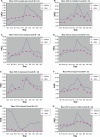Symptomatic treatment of premenstrual syndrome and/or primary dysmenorrhea with DLBS1442, a bioactive extract of Phaleria macrocarpa
- PMID: 21760747
- PMCID: PMC3133514
- DOI: 10.2147/IJGM.S21053
Symptomatic treatment of premenstrual syndrome and/or primary dysmenorrhea with DLBS1442, a bioactive extract of Phaleria macrocarpa
Abstract
Background: DLBS1442, a proprietary and standardized semipolar bioactive extract of the fruit Phaleria macrocarpa, is preclinically proven to have anti-inflammatory properties. The current clinical study evaluated the efficacy and safety of DLBS1442 in alleviating symptoms of premenstrual syndrome and primary dysmenorrhea.
Methods: This was an open study over four menstrual cycles (with two control cycles, followed by two treatment cycles). Women with premenstrual syndrome and/or primary dysmenorrhea, 18-40 years of age, and with a regular menstrual cycle were included in the study. In the treatment cycles, DLBS1442 extract was given as a 100 mg capsule two or three times daily (for those with mild and moderate-to-severe baseline abdominal pain, respectively), for an average of six days, ie, three days before until the end of the first three days of the menstrual period. Throughout all four study cycles, daily self-assessment of symptoms related to premenstrual syndrome was made by each subject using a visual analog scale (VAS). Data were descriptively analyzed and profiled in curves of VAS score versus time point evaluation starting from day 5 before menstruation to day 5 of menstruation.
Results: Twenty-three subjects of mean age 27.35 ± 5.73 years were evaluable for the intention to treat analysis. Most subjects experienced the primary efficacy variable (abdominal pain), peaking on days 1-2 of the menstrual phase, with a mean VAS score of 36.8 ± 24.3 mm and 30.0 ± 29.6 mm, respectively, during control cycles. DLBS1442 markedly reduced VAS scores by 13.76 ± 28.27 mm (37.46%) and 13.28 ± 29.06 mm (44.28%), respectively. Other symptoms of premenstrual syndrome were also markedly alleviated by DLBS1442. Some mild adverse events were observed and resolved by the end of the study.
Conclusion: This preliminary study indicates the effectiveness of DLBS1442 in alleviating primary dysmenorrhea and abdominal pain, as well as other symptoms related to premenstrual syndrome. DLBS1442 was safe and well tolerated in women with premenstrual syndrome and/or dysmenorrhea.
Keywords: DLBS1442; Phaleria macrocarpa; dysmenorrhea; premenstrual syndrome.
Figures












References
-
- Dickerson LM, Mazyck PJ, Hunter MH. Premenstrual syndrome. Am Fam Physician. 2003;67(8):1743–1752. - PubMed
-
- Rendas-Baum R, Yang M, Gricar J, Wallenstein GV. Cost-effectiveness analysis of treatments for premenstrual dysphoric disorder. Appl Health Econ Health Policy. 2010;8(2):129–140. - PubMed
-
- Frackiewicz EJ, Shiovitz TM. Evaluation and management of premenstrual syndrome and premenstrual dysphoric disorder. J Am Pharm Assoc (Wash) 2001;41(3):437–447. - PubMed
-
- Coco AS. Primary dysmenorrhea. Am Fam Physician. 1999;60(2):489–496. - PubMed
-
- Tonini G. Dysmenorrhea, endometriosis and premenstrual syndrome. Minerva Pediatr. 2002;54(6):525–538. - PubMed
LinkOut - more resources
Full Text Sources

